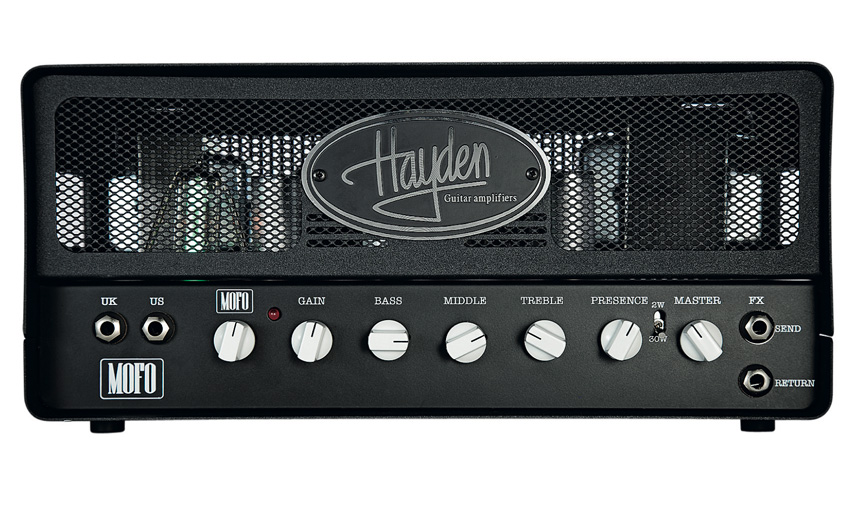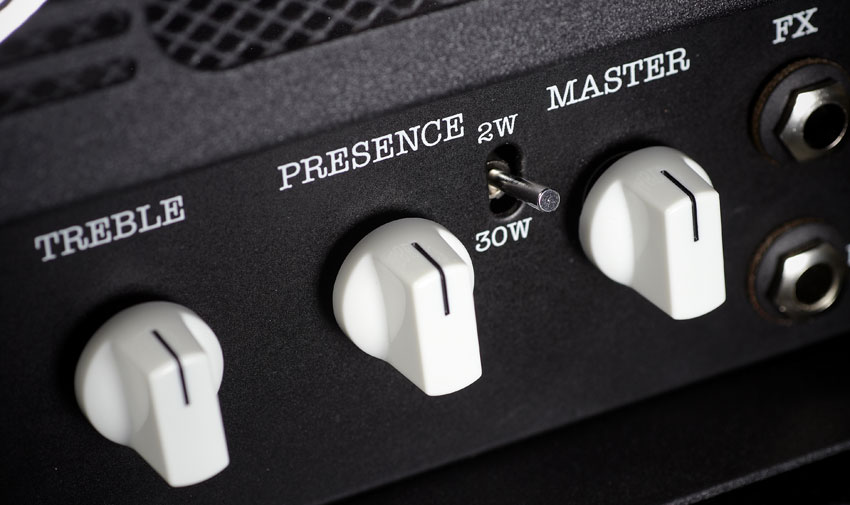MusicRadar Verdict
A superb new head from Hayden that looks set to find a lot of fans.
Pros
- +
Great tone and player-friendly response. Overdrive circuit.
Cons
- -
Could use an onboard switch for its boost function.
MusicRadar's got your back

Hayden MoFo 30

Powerswitch
Since 2006, Ashdown - the UK brand of world-class bass amp fame - has marketed its guitar amplifier range under the name of Hayden, a unique and separate identity. It's a tough market, but Hayden has gradually been winning acclaim on both sides of the Atlantic. Here we're looking at an amp from the recently revamped MoFo range, the redesigned 30-watt MoFo 30.
"It's a tough market, but Hayden has gradually been winning acclaim on both sides of the Atlantic"
First impressions are all-important and the heads in the new range score highly in the design, fit and finish departments. Top marks to Hayden for the restyling: the smart, purposeful case is folded steel with a black crackle finish that seems reasonably hard-wearing, and there's plenty of ventilation integrated into the covers, as well as a useful handgrip or two.
The chassis supports oversized mains and output transformers, which, at first glance at least, would indicate good things for tone. Inside, the electronics are mostly contained on one large high-quality through-plated PCB that holds the valve bases and front panel controls. The mains switch and socket are chassis-mounted on the rear panel, and what little wiring there is has been neatly executed.
In terms of its shouting voicing, the MoFo 30's power section comprises four EL84 valves - made famous, of course, by classic British amps including the Vox AC30, but also put to great use these days in amps including the Fender Blues Junior, among many.
In addition to an ECC83 driver, there's one other valve found here that's common to all of the new MoFo heads - an EM84 'magic eye'. Magic eye valves date back to the early days of radio when they were used as tuning aids, with a fluorescent 'cat's eye'- shaped display in the top of the valve that would move as stations were tuned in and out.
It's generally thought that Radio Corporation of America originated the 'magic eye' name. The EM84 has a dual-bar green display on the side and featured in many 1960s domestic reel-to-reel tape recorders as a level indicator. In the new Hayden MoFos, it's reincarnated as a cool status light, with both green bars moving up and down as you hit the strings: not exactly an essential inclusion, but very stylish nonetheless.
All of the new range of MoFo amps are single-channel designs when it comes to their front ends, with controls for gain, bass, mid and treble, plus an overall master volume. The MoFo 30 also features differently voiced high- and low-sensitivity input jacks, a presence control, a footswitchable boost with a separate 'MoFo' overdrive control, an effects loop with front-mounted send and return jacks, and a power reduction switch that reduces the output from 30 to just two watts.
Overall, this MoFo is built to last, with porcelain valve bases, quality neon-illuminated mains rocker switches, and stylish metalwork that's at least as good as anything we've seen from the competition.
Sounds
We tried out this new MoFo with a pair of Vintage 30-equipped 2x12 open- and closed-back cabinets, with a selection of guitars, including a Gibson Les Paul Studio, a PAF- equipped Les Paul Standard, a Fender Custom Shop Nocaster, and our regular Alnico Pro-loaded Strat.
"If it's headroom and punch you want, the larger MoFo 30 is ideally suited to live work, with a warm overall tonality"
If it's headroom and punch you want, the larger MoFo 30 is ideally suited to live work, with a warm overall tonality, power to spare and a footswitchable boost. The extra warmth and response may well have something to do with the amp's preamp valve; despite its aggressive attitude, we liked this amp's ever so slightly overdriven clean tones, which sounded excellent with a touch of reverb and chorus from an external pedal.
Kick in the MoFo overdrive circuit, and politeness and subtlety are replaced with aggression and filth by the bucket load, for rich powerchords and savage, sustained leads with a subtle edge that's just right for cutting through cymbals and keyboards.
Switching is smooth and quiet thanks to an opto-isolator rather than a relay. The MoFo's traditional bass, mid and treble controls are subtle, and interact smoothly with no annoying peaks, making the head quick and easy to fine-tune for the best results. Character wise, we have a definite British voice but with less of the midrange boxiness often associated with EL84-powered designs, making it tonally transparent and versatile.
Sometimes you can plug in to a new amplifier and make an instant musical connection, as well as an electrical one. It's almost as if you can get what you want from it without a struggle, while the amp responds the more you dig into it. The new MoFos have that elusive blend of great tone and dynamic response, combined with good looks and well above average build quality.
Pricing is very competitive and we think this new Hayden has got what it takes to succeed in a market sector awash with steel-cased, medium- and low-power heads. There's very little to grumble about - if the MoFo 30's footswitch had an extra button to defeat the effects loop it would have been even better, but at this price we're not complaining.
It's been a long time coming, but on this evidence Hayden looks set to hit the bullseye with this new MoFo range. Plug in soon.
“A synthesizer that is both easy to use and fun to play whilst maintaining a decent degree of programming depth and flexibility”: PWM Mantis review
“I feel like that song had everything we needed to come back with”: Bring Me The Horizon’s Lee Malia on Shadow Moses, its riff and the secrets behind its tone, and why it was the right anthem at the right time
“I said, ‘Are we sure we can write a song about death?’”: The story of Mike + The Mechanics' classic No.1 The Living Years









